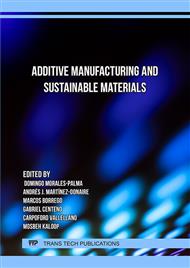[1]
Sartal A, Bellas R, Mejías AM, García-Collado A. The sustainable manufacturing concept, evolution and opportunities within Industry 4.0: A literature review. Advances in Mechanical Engineering. 2020;12: 1–17.
DOI: 10.1177/1687814020925232
Google Scholar
[2]
García-Collado A, Blanco JM, Gupta MK, Dorado-Vicente R. Advances in polymers based Multi-Material Additive-Manufacturing Techniques: State-of-art review on properties and applications. Additive Manufacturing. 2022;50: 102577.
DOI: 10.1016/j.addma.2021.102577
Google Scholar
[3]
Ilardo R, Williams CB. Design and manufacture of a Formula SAE intake system using fused deposition modeling and fiber‐reinforced composite materials. Rapid Prototyping Journal. 2010. p.174–179.
DOI: 10.1108/13552541011034834
Google Scholar
[4]
Chohan JS, Singh R. Enhancing dimensional accuracy of FDM based biomedical implant replicas by statistically controlled vapor smoothing process. Progress in Additive Manufacturing. 2016. 105–113.
DOI: 10.1007/s40964-016-0009-4
Google Scholar
[5]
Singh R, Paulo Davim J. Additive Manufacturing: Applications and Innovations. CRC Press; 2018.
Google Scholar
[6]
Dickson AN, Abourayana HM, Dowling DP. 3D Printing of Fibre-Reinforced Thermoplastic Composites Using Fused Filament Fabrication-A Review. Polymers . 2020;12.
DOI: 10.3390/polym12102188
Google Scholar
[7]
Yasa E. Additive Manufacturing of Polymer Matrix Composites. 2018.
Google Scholar
[8]
Türk D-A, Brenni F, Zogg M, Meboldt M. Mechanical characterization of 3D printed polymers for fiber reinforced polymers processing. Materials & Design. 2017. p.256–265.
DOI: 10.1016/j.matdes.2017.01.050
Google Scholar
[9]
Fidan I, Imeri A, Gupta A, Hasanov S, Nasirov A, Elliott A, et al. The trends and challenges of fiber-reinforced additive manufacturing. The International Journal of Advanced Manufacturing Technology. 2019.
DOI: 10.1007/s00170-018-03269-7
Google Scholar
[10]
Kim T-H, Lee E-H. Planar reinforcement by sheet type stiffeners for fused deposition modeling. Journal of Mechanical Science and Technology. 2020.
DOI: 10.1007/s12206-020-0912-y
Google Scholar
[11]
Ferreira RTL, Amatte IC, Dutra TA, Bürger D. Experimental characterization and micrography of 3D printed PLA and PLA reinforced with short carbon fibers. Composites Part B. 2017;124: 88–100.
DOI: 10.1016/j.compositesb.2017.05.013
Google Scholar
[12]
Lu J, Xu L, Hu J. Micromechanical analysis of the tensile deformation behavior for 3D printed unidirectional continuous fiber reinforced thermos-plastic composites. Journal of Mechanical Science and Technology. 2020.
DOI: 10.1007/s12206-020-1112-5
Google Scholar
[13]
Justo J, Távara L, García-Guzmán L, París F. Characterization of 3D printed long fibre reinforced composites. Compos Struct. 2018;185.
DOI: 10.1016/j.compstruct.2017.11.052
Google Scholar
[14]
Yu T, Zhang Z, Song S, Bai Y, Wu D. Tensile and flexural behaviors of additively manufactured continuous carbon fiber-reinforced polymer composites. Compos Struct. 2019;225,111147.
DOI: 10.1016/j.compstruct.2019.111147
Google Scholar
[15]
Imeri A, Fidan I, Allen M, Wilson DA, Canfield S. Fatigue analysis of the fiber reinforced additively manufactured objects. The International Journal of Advanced Manufacturing Technology. 2018. p.2717–2724.
DOI: 10.1007/s00170-018-2398-7
Google Scholar
[16]
Mohammadizadeh M, Imeri A, Fidan I, Elkelany M. 3D printed fiber reinforced polymer composites - Structural analysis. Composites Part B: Engineering. 2019. p.107112.
DOI: 10.1016/j.compositesb.2019.107112
Google Scholar
[17]
Caminero MA, Chacón JM, García-Moreno I, Reverte JM. Interlaminar bonding performance of 3D printed continuous fibre reinforced thermoplastic composites using fused deposition modelling. Polym Test. 2018;68: 415–423.
DOI: 10.1016/j.polymertesting.2018.04.038
Google Scholar
[18]
Iragi M, Pascual-González C, Esnaola A, Lopes CS, Aretxabaleta L. Ply and interlaminar behaviours of 3D printed continuous carbon fibre-reinforced thermoplastic laminates; effects of processing conditions and microstructure. Additive Manufacturing. 2019;30: 100884.
DOI: 10.1016/j.addma.2019.100884
Google Scholar
[19]
Yavas D, Zhang Z, Liu Q, Wu D. Interlaminar shear behavior of continuous and short carbon fiber reinforced polymer composites fabricated by additive manufacturing. Composites Part B. 2021;204: 108460.
DOI: 10.1016/j.compositesb.2020.108460
Google Scholar
[20]
Laffan MJ, Pinho ST, Robinson P, McMillan AJ. Translaminar fracture toughness testing of composites: A review. Polym Test. 2012;31: 481–489.
DOI: 10.1016/j.polymertesting.2012.01.002
Google Scholar
[21]
Sutton MA, Orteu JJ, Schreier H. Image Correlation for Shape, Motion and Deformation Measurements: Basic Concepts,Theory and Applications. Springer Science & Business Media; 2009.
DOI: 10.1007/978-0-387-78747-3
Google Scholar
[22]
Vasco‐Olmo JM, Díaz FA. Experimental evaluation of crack shielding during fatigue crack growth using digital image correlation. Fatigue Fract Eng Mater Struct. 2015.
DOI: 10.1111/ffe.12136
Google Scholar



